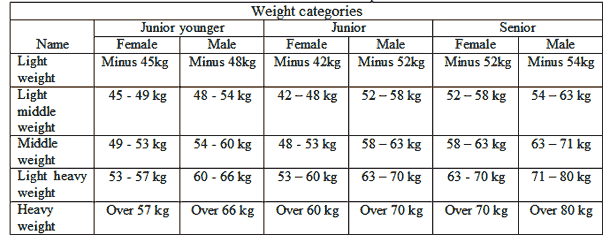
The evaluation of the efficiency of various techniques in Taekwon-Do female sparing over 70 kg
Jacek Wąsik, Andrzej Ślęzak
Jacek Wąsik
The Faculty of Environment Physics in the Pedagogical University of Czestochowa,
ul. Armii Krajowej 13/15, 42-200 Częstochowa
Andrzej Ślęzak
The Faculty of Biomechanics and Bases of Physical Education, Polytechnics in Częstochowa,
ul. Armii Krajowej 19b, 42-200 Częstochowa
Abstract
The authors present a short characteristic of ITF Taekwon-Do and the general competition system. Based on the registered material from female sparing over 70 kg during the 2002 Polish Championships an efficiency analysis of several techniques is conducted.
From the quantative analysis it can be observed that the female competitors in the weight category of over 70kg use only two types of punches and four types of kicks. This means that the competitors were focused on using relatively simple techniques. The range of used techniques was limited to the basic punches and a number of fast and simple kicks. The most commonly used technique was the punch Ap Joomok Jirugi. When analyzing the quantity of punches and the quantity of kicks one must come to the conclusion that the female sparing over 70 kg is dominated by punches, the fighters have used punches several times more often then kicks. The results of this analyses point out that one must develop the use of punches and change the use of kikes in sparing.
Key words: taekwon-do, efficiency techniques.
Introduction
Taekwon-do (tae - foot, kick; kwon - fist, punch; do - the path, art spiritual evolution) is a self defense art developed by a Korean general Choi Chong Chi in 1955. According to it's maker, Taekwon-Do is the a way to discipline the mind by disciplining the body. Initially developed for army purposes, taekwon-do has gradually evolved into a very efficient self defense system that includes social and educational aspects based on 5 simple rules: courtesy integrity, perseverance, self-control, indomitable spirit. The characteristic features of taekwon-do are: terminology, the theory of force, training methods teaching system, ethics and philosophy, techniques ranking system and the system of examination requirements uniforms and equipment.
The dynamic evolution in Taekwon-Do sport competition is dated back to the mid 80's of the past century. It can be proved by the constant increase in the amount of competitors tacking part in tournaments, as well as by the increase of the amount of the tournaments. The increase in competition forces the coaches to look for new training and tactical solutions. The main purpose of this theses is the analysis of the efficiency of the most commonly used Taekwon-Do techniques based on the competition of female over 70 kg sparing during the 2002 Polish Championships. The fights have been recorded on a video tape, next a quantative analysis has been conducted, all punches (jirugi, twimyo jirugi) as well as all kicks (dollyo chagi, yopcha jirugi, dwitcha jirugi, goro chagi, naeryo chagi) used successfully and those witch were unsuccessful have been counted along with the attempts of using these techniques.
The competition of sparing in Taekwon-Do ITF
The competition of taekwon-do according to ITF (International Taekwon-Do Federation) is a quadrotlon and consists of: patterns, sparing, special techniques and power braking. Each of this events is conducted in individual and team categories, both for male and female competitors.
The individual sparing competition is conducted in the cup system, there are 5 weight categories. The qualifying fights have two rounds, two minutes each, with a one minute brake between the rounds. The final fights have three two minute rounds with one minute brakes between the rounds. Table 1 contains Taekwon-Do ITF weight categories in specific age categories.
Table 1.
Weight categories for junior younger, junior and senior competitors Weight categories

In the teem sparing competition fights take place without the division of competitors into weight categories. The coaches of both teems present the lists of competitors placed in the teem. The ring referee draws the teem witch will appoint the first competitor. For the second fight a member of the second teem is appointed and so on. No competitor is allowed to fight twice. The teem witch climes the most victories is announced the winner. Each contest is a two minute round.
Materials and methods
The efficiency analysis was conducted during the Polish Championships 2002 in Ciechanów on the bases of all contests in the female over 70 kg category. All fights were recorded with a digital camcorder in the "digital8" format. During the analysis all punches (jirugi, twimio jirugi) and kicks (dollio chagi, yopcha jirugi, goro chagi, nerio chagi, dwitcha jirugi) as well as the attempts of using these particular techniques have been counted. By the technique efficiency we understand the percentage of all successful techniques compared to all techniques uttered.
The results
Research results have been presented in table number 2 and are also visible on figures 1, 2, 3 and 4.
The registered results show that 18 techniques were successfully used, 10 of them were punches jirugi and 6 were kicks: 3 dollyo chagi and 3 yopcha jirugi.
The research has shown 101 unsuccessful techniques: 52 - punches jirugi, 31 - dollyo chagi kicks, 8 - yopcha jirugi kicks, 2 - dwitcha jirugi kicks and 2 naeryo chagi kicks.
The research has also shown 13 attempts to use wearies techniques 6 - yppcha jirugi kicks, 3 - dollyo chagi kicks, 2 - naeryo chagi kicks and 2 - jirugi punches.
The most commonly used was the punch jirugi (64 times). The second commonly used technique was the kick dollo chagi (37 times), next were yopcha jirugi (17 times), twimyo jirugi (8 times), naeryo chagi (4 times) and dwitcha jirugi (2 times). The techniques goro chagi and bandae dollyo chagi have not been indicated. The least commonly used technique was the kick dwitcha jirugi (2 times).
Table 2.
The efficiency of various techniques in Taekwon-Do female sparing over 70 kg during the 2002 Polish Championships in Ciechanów
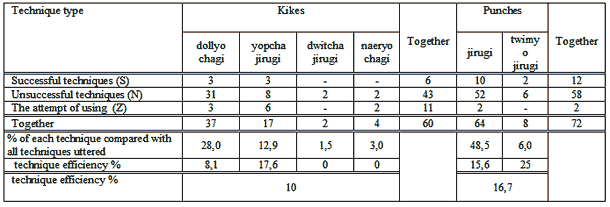
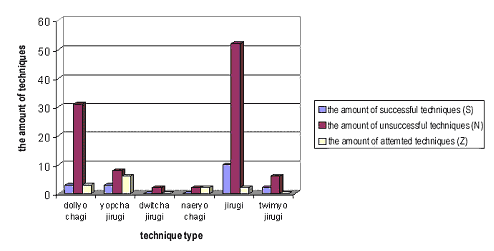
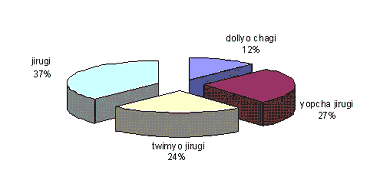
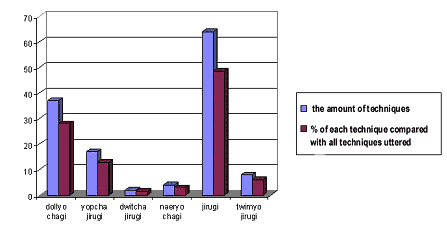
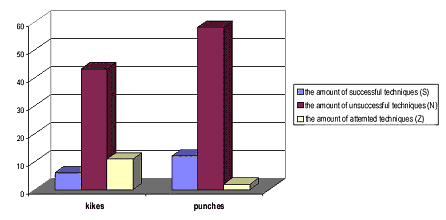

The above placed table shows that from the 18 successful techniques 6 (that makes 38%) were kicks, and 12 (that makes 62%) were punches. In the case of the 101 unsuccessful techniques 43 were kicks and 58 were punches. In 13 cases (11 kikes and 2 punches) attempts to use a technique have been made. The conducted analysis shows that punches were the most efficient techniques used by the competitors. The table shows their efficiency was placed at a ratio of 16,7%, and the efficiency of kicks was at the rate of 10%.
Discussion
From the quantative analysis it can be observed that the female competitors in the weight category of over 70kg used only two types of punches and four types of kicks. This means that the competitors were focused on using relatively simple techniques. The range of used techniques was limited to the basic punches and a number of fast and simple kicks.
The most commonly used technique was the punch Ap Joomok Jirugi. This technique is not a very complex, fist, forward punch which allows the competitor to control the force of the punch. The fighters have used this technique in series of 2-3 or more punches, very rarely as a singular attack.
Dolio chagi and yopcha jirugi were the most commonly used kicks. Using the foot closer to the opponent, these kicks have initiated almost every fight. Yopcha jirugi is a technique witch gives the competitor a great sense of security during the attack. The most commonly used among the kicks were dolio chagi and yopch jirugi used as a singular attack initiating a combination.
Another commonly used attack was a series of punches. The least commonly used were combinations of punches and kicks which allow the opponent to counter attack, although the competitors often pretended to kick in order to reduce the distance to their opponent and use punches to score points.
When analyzing the quantity of punches and the quantity of kicks one must come to the conclusion that the female sparing over 70 kg is dominated by punches, the fighters have used punches several times more often then kicks. As to the tactical solutions one must come to the conclusion that the majority of attacks were conducted as a series.
Conclusions
Based on the analysis the following conclusions can be uttered:
Bibliography:
Author's note:
Jacek Wąsik, Ph. D. works in the Faculty of Environment Physics in the WSP in Częstochowa. Main field of research is Biophysics and the Physics of Sport. He is a first class Taekwon-Do coach. He is the coach of the Silesian Junior Taekwon-Do Team.
Professor Andrzej Ślęzak, Ph. D. manages The Faculty of Biomechanics and Bases of Physical Education of the Polytechnics in Częstochowa. His interests include the use of unbalanced thermodynamics in biology and medicine.
Materials were presented on the Scientific Conference: "Sport training in interdisciplinary scientific researches" in Czestochowia in term 21-22.10.04 and in abstract book "Directions of development of scientific research in sports training" published by: Politechnika Czestochowska 2004.